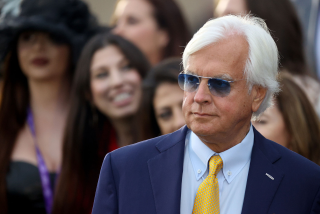Testimony Given to Dispel Sabotage Theories : Chemist’s Evidence Shows Link Between Johnson’s Doctor and Stanozolol
- Share via
TORONTO — After saying two weeks ago that there was no substance to sabotage theories surrounding Ben Johnson’s positive drug test in the 1988 Summer Olympics, the co-counsel for the Canadian government’s commission of inquiry into drug use by athletes reinforced his position Wednesday with scientific evidence.
Robert P. Armstrong established through testimony from a chemist that the drug allegedly given to several Canadian track and field athletes by Dr. Jamie Astaphan contained stanozolol, the anabolic steroid found in Johnson’s system at Seoul.
Further testimony revealed that the drug’s brand name is Winstrol V, a veterinary preparation that is indicated for use only in the treatment of animals.
Outside the hearing room, Astaphan’s attorney, David Sookram, would acknowledge only that there appears to be a link between his client and stanozolol.
He said that he believes Astaphan will provide an explanation when he testifies. Astaphan, who lives on the Caribbean island of St. Kitts, is expected to appear before the commission later this month.
The evidence presented Wednesday is the most damaging to date against Astaphan because it seems to confirm previous testimony that he lied to athletes, treating them with stanozolol while telling them it was a different anabolic steroid.
Sookram would not say whether his client gave the athletes stanozolol, but the attorney said that Astaphan will testify that he did not mislead them.
The identity of the steroid became an issue when Johnson’s coach, Charlie Francis, testified in March that it was impossible for the sprinter to have tested positive for stanozolol in the 1988 Summer Olympics because he had not used that drug since the spring of 1987.
Francis admitted that Johnson had been on a steroid program since 1981, including one two-week cycle that ended only 22 days before the 100-meter final at Seoul Sept. 24. Johnson produced his positive urine sample after that race.
But Francis said that Astaphan told him he had been treating the athletes with a drug he identified as Estragol, which, according to the doctor, contained the steroid furazabol.
That led Francis to conclude that Johnson’s drug test had been sabotaged. He suggested that an unidentified man believed to be an acquaintance of Carl Lewis had spiked Johnson’s drink with stanozolol in the doping control station before the test.
But another of Francis’ athletes, sprinter Angella Taylor Issajenko, subsequently testified that she suspected Astaphan had actually given the athletes stanozolol while telling them it was Estragol, which may not exist. No drug under that brand name can be found in a standard physician’s reference book.
Issajenko stored the drugs for Francis’ athletes, including Johnson, in her house. She turned over all 12 remaining vials of the substance in question to a commission investigator, Walter Greczko, who testified Wednesday that they subsequently were tested in a laboratory at the Canadian government’s Health and Protection Branch near Toronto.
Greczko submitted documents revealing that the substance contained stanozolol. A chemist at the laboratory, Andrew Holmes, testified that the substance had the same components as Winstrol V.
A representative of Sterling Drug Ltd. testified last week that Astaphan ordered so much Winstrol V from the company between 1984 and 1987 that it was assumed he was a veterinarian.
Sookram said that it still has not been proven that the drugs in Issajenko’s house came from Astaphan.
“The link seems to be established,” he said. “But the question is still, who put it there and how it got there. The question of whether the doctor put it there will be clarified when he comes to testify.”
More to Read
Go beyond the scoreboard
Get the latest on L.A.'s teams in the daily Sports Report newsletter.
You may occasionally receive promotional content from the Los Angeles Times.






